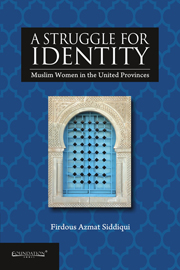Book contents
- Frontmatter
- Contents
- Acknowledgements
- Introduction
- 1 Social Stratification of Muslim Women in the United Provinces
- 2 Socio-religious Movement and the Muslim Women's Issue
- 3 British Perception of Muslim Women: Questions of Fecundity and Health
- 4 Crises in the Social and Economic Identity of Muslim Women: The Great Uprising of 1857
- 5 Changing Profile of Muslim Women through Education
- 6 Patriarchy and Social Obligation of Indian Muslim Women
- 7 Cultural Clash: From Tawaif to Kasbi
- 8 Law, Land and Muslim Women: The Economic Situation
- 9 Muslim Women's Response to the New Judicial System
- Conclusion
- Glossary
- Bibliography
- Index
Introduction
Published online by Cambridge University Press: 05 October 2014
- Frontmatter
- Contents
- Acknowledgements
- Introduction
- 1 Social Stratification of Muslim Women in the United Provinces
- 2 Socio-religious Movement and the Muslim Women's Issue
- 3 British Perception of Muslim Women: Questions of Fecundity and Health
- 4 Crises in the Social and Economic Identity of Muslim Women: The Great Uprising of 1857
- 5 Changing Profile of Muslim Women through Education
- 6 Patriarchy and Social Obligation of Indian Muslim Women
- 7 Cultural Clash: From Tawaif to Kasbi
- 8 Law, Land and Muslim Women: The Economic Situation
- 9 Muslim Women's Response to the New Judicial System
- Conclusion
- Glossary
- Bibliography
- Index
Summary
Social changes in the 19th century focused primarily on women, whose independence had been completely eroded by socio-religious customs which regulated the age of marriage, education, widow re-marriage, inheritance, etc. By and large there was a general acceptance of the need for change but due to the politicization of group solidarity and the need to maintain identity, the debate on reform was between those who opted for covert change with no open rejection of past customs and practices which would make community solidarity in political and economic terms more difficult and those who felt social change to be necessary prerequisite for the desired political and economic changes in the community. The reaction was fairly widespread as it was a response not to social reform, but to the all-pervasive political changes underway.
Shaheeda LateefThis book attempts to understand the social and economic profile of women, particularly the Muslim women of the United Provinces. The first question that lay before me while starting this book was: Why choose the United Provinces (UP) and not those regions where Muslims live in sizeable numbers? The Sachar Committee Report of November 2006 states that Indian Muslims lag behind others in development indices, and that the condition of Indian Muslim women is worse than that of Dalit women. The report's data and analysis highlights the pathetic condition of their education and socio-economic status in UP.
- Type
- Chapter
- Information
- A Struggle for IdentityMuslim Women in United Provinces, pp. vii - xxxPublisher: Foundation BooksPrint publication year: 2014

